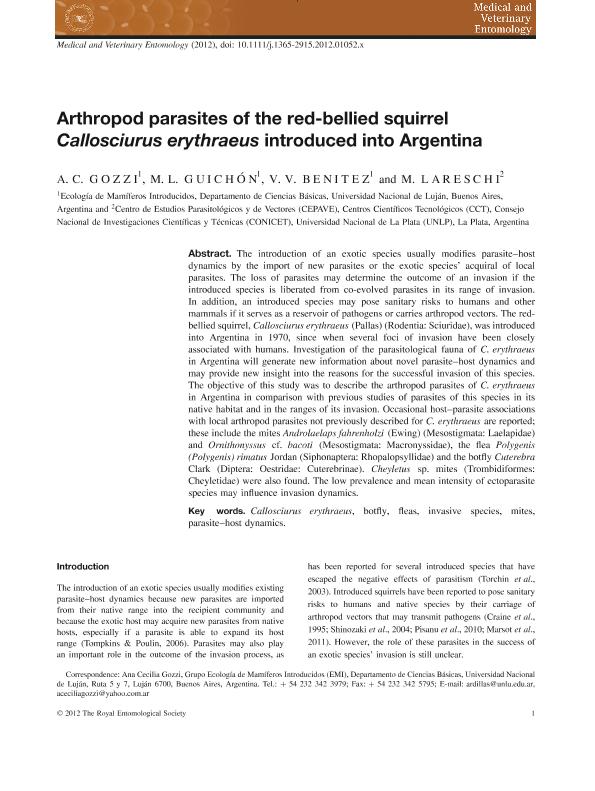Mostrar el registro sencillo del ítem
dc.contributor.author
Gozzi, A. C.
dc.contributor.author
Guichon, M. L.
dc.contributor.author
Benitez, V. V.
dc.contributor.author
Lareschi, Marcela

dc.date.available
2017-01-12T22:02:21Z
dc.date.issued
2013-06
dc.identifier.citation
Gozzi, A. C.; Guichon, M. L.; Benitez, V. V.; Lareschi, Marcela; First report of ectoparasites associated with Red Bellied Squirrel Callosciurus erythraeus (Rodentia: Sciuridae) introduced into Argentina; Wiley Blackwell Publishing, Inc; Medical And Veterinary Entomology; 27; 2; 6-2013; 203-208
dc.identifier.issn
0269-283X
dc.identifier.uri
http://hdl.handle.net/11336/11275
dc.description.abstract
Introduced species usually modify parasite-host dynamics by bringing new parasites or by acquiring local parasites. The loss of parasites may determine the outcome of invasions, if introduced species are liberated from their coevolved parasites in the invaded range. Also, introduced species may pose sanitary risks to humans and other mammals, if they are reservoir of pathogens or carry arthropod vectors. The red-bellied squirrel, Callosciurus erythraeus (Pallas) (Rodentia: Sciuridae), was introduced into Argentina in 1970 and since then, several foci of invasion appeared closely associated with humans. Parasitological fauna of C. erythraeus in Argentina will inform about novel parasite-host dynamics and may provide new insight into their invasion success. The objective of this study was to describe the arthropod parasites of C. erythraeus in Argentina in comparison with previous studies conducted in native and introduced ranges. Occasional host-parasite associations with local arthropod parasites not previously described for C. erythraeus are reported: the mites Androlaelaps fahrenholzi (Ewing) (Parasitiformes: Laelapidae) and Ornithonyssus cf. bacoti (Parasitiformes: Macronyssidae), the flea Polygenis (Polygenis) rimatus Jordan (Siphonaptera: Rhopalopsyllidae) and the botfly Cuterebra Clark (Diptera: Oestridae: Cuterebrinae). Cheyletus sp. mites (Acariformes: Cheyletidae) were also found. Low prevalence and mean intensity of ectoparasite species could influence invasion dynamics.
dc.format
application/pdf
dc.language.iso
eng
dc.publisher
Wiley Blackwell Publishing, Inc

dc.rights
info:eu-repo/semantics/openAccess
dc.rights.uri
https://creativecommons.org/licenses/by-nc-sa/2.5/ar/
dc.subject
Parasite-Host Dynamics
dc.subject
Callosciurus Erythraeus
dc.subject
Bot Fly
dc.subject
Fleas
dc.subject.classification
Conservación de la Biodiversidad

dc.subject.classification
Ciencias Biológicas

dc.subject.classification
CIENCIAS NATURALES Y EXACTAS

dc.title
First report of ectoparasites associated with Red Bellied Squirrel Callosciurus erythraeus (Rodentia: Sciuridae) introduced into Argentina
dc.type
info:eu-repo/semantics/article
dc.type
info:ar-repo/semantics/artículo
dc.type
info:eu-repo/semantics/publishedVersion
dc.date.updated
2016-11-24T19:26:03Z
dc.journal.volume
27
dc.journal.number
2
dc.journal.pagination
203-208
dc.journal.pais
Reino Unido

dc.journal.ciudad
Londres
dc.description.fil
Fil: Gozzi, A. C.. Universidad Nacional de Luján; Argentina
dc.description.fil
Fil: Guichon, M. L.. Universidad Nacional de Luján; Argentina
dc.description.fil
Fil: Benitez, V. V.. Universidad Nacional de Luján; Argentina
dc.description.fil
Fil: Lareschi, Marcela. Consejo Nacional de Investigaciones Científicas y Técnicas. Centro Científico Tecnológico La Plata. Centro de Estudios Parasitológicos y de Vectores (i); Argentina. Universidad Nacional de La Plata; Argentina
dc.journal.title
Medical And Veterinary Entomology

dc.relation.alternativeid
info:eu-repo/semantics/altIdentifier/url/http://onlinelibrary.wiley.com/doi/10.1111/j.1365-2915.2012.01052.x/abstract
dc.relation.alternativeid
info:eu-repo/semantics/altIdentifier/doi/http://dx.doi.org/10.1111/j.1365-2915.2012.01052.x
Archivos asociados
